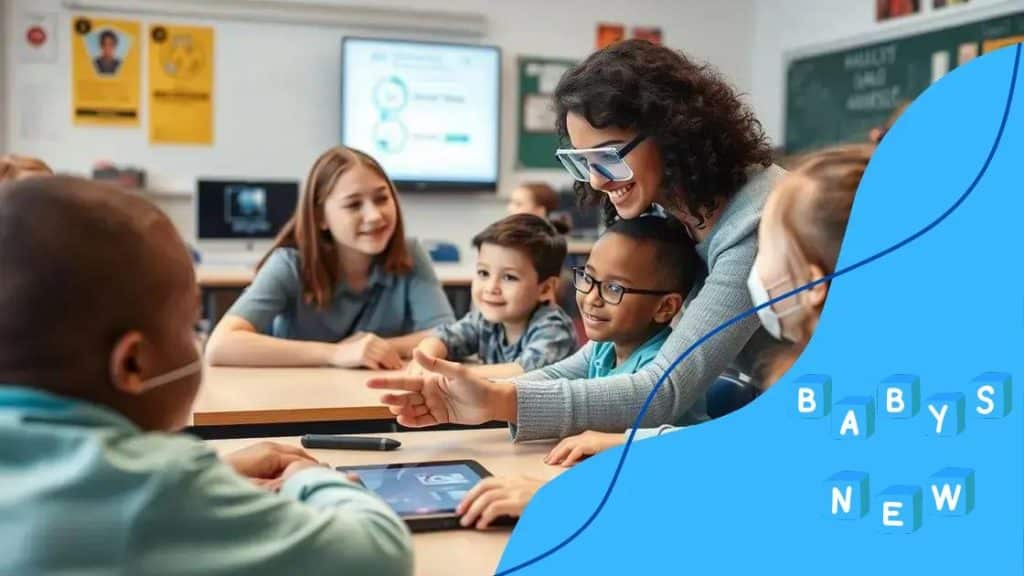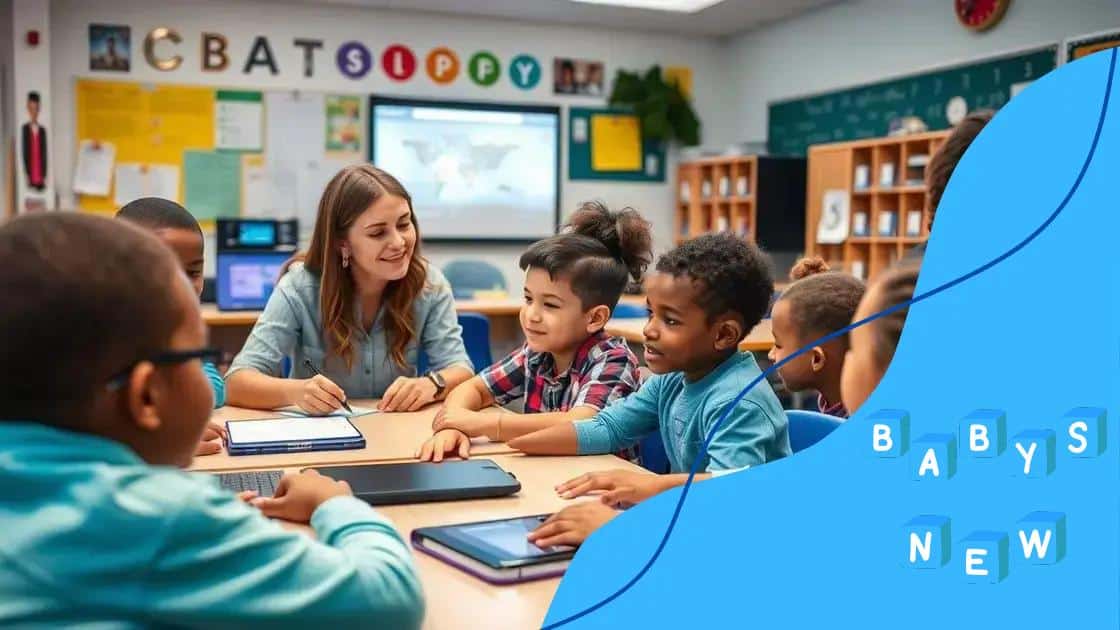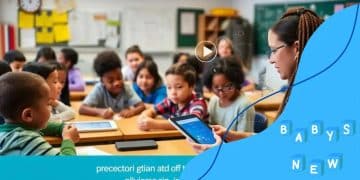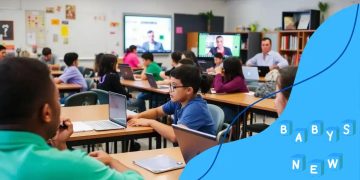AI in special education: transforming learning experiences

Advertisement
AI in special education enhances learning by offering personalized experiences, improving teacher support through data analysis, and addressing diverse learning needs effectively.
AI in special education is reshaping how educators support diverse learners. Have you ever wondered how technology can create more inclusive environments? Let’s dive into this fascinating topic.
Understanding the role of AI in special education
Understanding the role of AI in special education is crucial for improving learning experiences for all students. With the right tools, educators can offer tailored support that meets individual needs.
The Importance of AI
AI enhances the learning process by analyzing data and providing insights into each student’s unique challenges and strengths. Teachers can better understand these factors, which helps them adapt their instruction effectively.
Advertisement
Key Benefits
- Personalized learning paths that cater to diverse abilities.
- Real-time feedback for both students and teachers.
- Increased engagement through interactive learning tools.
Such tools can create personalized roadmaps for students, guiding their progress while making learning fun and engaging. In addition to enhancing instruction, AI supports teachers in recognizing when students may need additional resources.
For example, AI can help identify when a student is struggling with a specific topic. This allows educators to intervene promptly, ensuring that no student falls behind. Moreover, AI can be an excellent ally in organizing and managing classroom activities more efficiently, enabling teachers to focus on what truly matters—student learning.
Implementing AI Solutions
To incorporate AI tools effectively, schools must invest in training teachers and providing them with adequate resources. The transition might seem daunting, but the benefits are substantial. A collaborative approach, where educators share experiences and outcomes, can facilitate smoother implementations.
Advertisement
- Fostering an inclusive environment by using AI-driven tools.
- Creating adaptability in lesson planning to suit all learners.
- Encouraging teamwork among educators to utilize AI platforms.
Ultimately, AI in special education holds the potential to transform classrooms and enrich learning experiences. As schools embrace these technologies, the focus on every student’s unique journey will become stronger, benefiting both learners and educators alike.
Personalized learning through AI tools
Personalized learning through AI tools has revolutionized the educational experience for students. These technologies adapt to individual learning styles, ensuring that each learner receives the support they need.
Benefits of Personalized Learning
When students engage with AI tools, they can work at their own pace. This flexibility allows learners to grasp concepts thoroughly before moving on. Additionally, personalized feedback keeps students motivated by addressing their specific challenges.
- Customized learning experiences tailored to individual needs.
- Immediate feedback to track progress and understanding.
- Engagement through interactive and adaptive learning platforms.
Furthermore, these tools can analyze data from students’ interactions. By understanding areas of difficulty, educators can design lessons that focus on the needed concepts. This customization leads to a more inclusive educational environment where every student feels valued.
Implementing AI in the Classroom
To effectively implement personalized learning, schools should provide the necessary training for teachers. When educators understand how to integrate AI tools into their lessons, students greatly benefit. Collaboration among teachers can ensure that these tools are used effectively across different subjects.
Introducing AI into classrooms may seem challenging, but the payoff is substantial. Schools that embrace these technologies often see improved student outcomes. In addition, personalized learning fosters a sense of ownership in students, as they take charge of their educational journey.
- Encouraging student autonomy in the learning process.
- Facilitating collaboration among educators to share best practices.
- Investing in ongoing professional development for teachers.
AI tools make it easier for educators to track progress and adapt teaching methods to fit the diverse needs of their students. This approach not only improves academic performance but also supports emotional well-being by providing students with the resources they require to succeed.
Benefits of AI for teachers and students

The benefits of AI for teachers and students are becoming increasingly clear. These technologies not only enhance learning experiences but also improve teaching efficiency. By embracing AI, educators can create a better environment for student success.
Enhancing Instructional Strategies
AI tools assist teachers in developing tailored instructional strategies. By analyzing student performance data, these tools can recommend adjustments to teaching methods. This allows educators to personalize lessons in ways that meet individual student needs effectively.
- Targeting specific learning gaps.
- Differentiating instruction for various learning styles.
- Providing actionable insights into student progress.
Teachers can spend less time grading and planning, allowing them to focus more on engaging with students. This can lead to stronger relationships and improved classroom dynamics, which are essential for learning.
Empowering Student Engagement
AI also promotes higher student engagement. Interactive learning platforms capture student interest by making lessons more dynamic. These tools offer real-time feedback, which motivates students to take charge of their learning. As they see progress, their confidence grows.
Moreover, AI tools can make learning fun through gamification. By integrating game-like elements, students are encouraged to participate actively. This method keeps them invested in their education and fosters a sense of achievement.
- Encouraging a growth mindset.
- Boosting participation through interactive lessons.
- Creating a safe space for exploration and learning.
As students engage with AI-driven educational tools, they develop important skills such as critical thinking and problem-solving. The collaborative use of these tools helps create a well-rounded educational experience that prepares them for future challenges.
Challenges of implementing AI in classrooms
The challenges of implementing AI in classrooms can be significant, but understanding them is the first step toward overcoming these barriers. Integrating new technology into education often raises questions about resources, training, and effectiveness.
Resources and Infrastructure
First, schools must have reliable technology and infrastructure in place. Many classrooms lack the necessary devices and internet access to support AI tools. This digital divide affects how effectively students can engage with these new learning methods.
- Insufficient funding for tech upgrades.
- Lack of access to high-speed internet in some areas.
- Limited availability of devices for all students.
Without the right resources, teachers cannot deliver personalized learning experiences. Moreover, transition to AI-driven systems requires careful planning and investment. This can be a challenge for schools with limited budgets.
Teacher Training and Support
Another important challenge is ensuring teachers receive adequate training on how to use AI tools effectively. Teachers need to feel comfortable and confident in their ability to integrate these technologies into their lesson plans. Professional development programs should focus on practical applications of AI in education.
Training that is supportive and ongoing helps teachers adapt to new tools more easily. When educators are well-equipped, they can leverage AI to enhance their teaching methods.
- Creating a comprehensive training program for teachers.
- Encouraging collaboration among educators to share experiences.
- Providing continuous technical support as needed.
However, the reluctance to change can also be a barrier. Some educators may resist adopting new teaching practices due to uncertainty about their effectiveness. Building a culture that encourages innovation and experimentation is essential for successful implementation.
Addressing Data Privacy Concerns
Implementing AI also raises concerns about student data privacy. Schools must ensure the safety of the information collected by these tools. Educators and administrators need to establish clear policies regarding data use to protect students.
Transparency in how data is collected and utilized can help build trust among parents and the community. It is vital that schools educate stakeholders about how AI enhances learning while respecting privacy.
Future trends of AI in special education
The future trends of AI in special education promise exciting developments that can enhance the learning experience for students with diverse needs. As technology evolves, so does the potential for creating more inclusive classrooms.
Increased Personalization
One major trend is the ongoing move toward greater personalization. Future AI tools will be able to analyze student behavior in real-time. This will allow for immediate adjustments to learning content, ensuring that each student receives the right level of challenge.
- Adaptive learning systems that learn and adjust to student progress.
- Customized content based on individual learning styles.
- Real-time feedback and analytics for both students and teachers.
As these tools become more sophisticated, they will help educators address each child’s specific strengths and weaknesses. This can lead to a more effective learning environment where every student can thrive.
Integration of Social-Emotional Learning
Furthermore, future AI in special education will integrate social-emotional learning (SEL) into the curriculum. AI tools will be designed not just to address academic skills but also to support emotional intelligence and peer relationships.
By incorporating SEL, AI can help students develop important social skills, which are crucial for their overall development. Educators can track students’ emotional well-being and adjust their approaches as needed.
- AI-supported chatbots for emotional support.
- Tools that help students practice empathy and collaboration.
- Monitoring emotional trends to adapt teaching strategies.
This holistic approach can significantly enhance the educational experience, leading to well-rounded student development.
Enhanced Accessibility Through Technology
As AI continues to evolve, accessibility will improve dramatically. Future innovations will include advanced speech recognition and natural language processing, allowing students with disabilities to interact seamlessly with learning materials.
Such advancements could lead to tools that help students communicate and express themselves more effectively, bridging gaps that traditional methods may leave open.
Additionally, AI-driven technologies will likely support a variety of learning formats, making education more accessible to everyone. This will ensure that students with disabilities have equal opportunities to engage with their education alongside their peers.
FAQ – Frequently Asked Questions about AI in Special Education
What are the main benefits of using AI in special education?
AI provides personalized learning experiences, helps track student progress, and enhances engagement, making education more accessible for all learners.
How does AI help teachers in the classroom?
AI assists teachers by analyzing student data, allowing for customized lesson plans and providing real-time feedback on student performance.
What challenges does AI face in special education?
Challenges include limited resources, the need for teacher training, and concerns about data privacy and accessibility.
What future trends can we expect with AI in education?
Future trends include increased personalization, integration of social-emotional learning, improved accessibility, and enhanced tools that support diverse learners.





